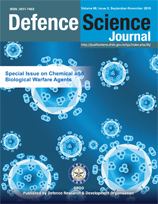Biological Warfare Agents and their Detection and Monitoring Techniques (Review Paper)
DOI:
https://doi.org/10.14429/dsj.66.10704Keywords:
Biological warfare agents, biothreat, biosensor, detection, PCRAbstract
Recently, threat from biological warfare agents (BWAs) has emerged as the foremost national and global security challenge because of their simple and cheap production, easy dispersal, complicated detection, expensive protection and psychological, economical and social impact. Early detection and identification of BWAs during intentional biological event is essential to initiate corrective emergency responses for management of such incidents. Efforts are being made across the globe for development of state of the art technologies and systems for detection and identification of BWAs. However, till date there is no single system which can detect all the biothreat agents. In the present review, we describe the currently available techniques and systems for detection and identification of these agents. The basic identification techniques including biological culture, immunological methods, nucleic acid based detection, MALDI-TOF MS, cellular fatty acid profiling and flow cytometry based detection are presented. Detection of BWAs with biosensors, surface plasmon resonance, biological detectors, and stand-off detection systems is also summarized. However, despite of availability of several techniques and tools, no full proof system is available for detection/identification of all the BWAs.Downloads
Published
2016-09-30
How to Cite
Pal, V., Sharma, M., Sharma, S., & Goel, A. (2016). Biological Warfare Agents and their Detection and Monitoring Techniques (Review Paper). Defence Science Journal, 66(5), 445–457. https://doi.org/10.14429/dsj.66.10704
Issue
Section
Special Issue Papers
License
 Where otherwise noted, the Articles on this site are licensed under Creative Commons License: CC Attribution-Noncommercial-No Derivative Works 2.5 India
Where otherwise noted, the Articles on this site are licensed under Creative Commons License: CC Attribution-Noncommercial-No Derivative Works 2.5 India


